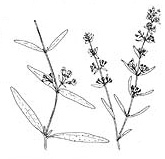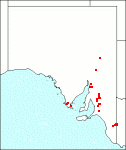Family: Lamiaceae
Mentha satureioides
Citation:
R. Br., Prod. Fl. Nov. Holl. 505 (1810).
Synonymy: Not Applicable Common name: Creeping mint, native pennyroyal.
Description:
Perennial herbs more or less mat-forming, with an underground rhizome often rooting at the nodes, producing ascending to prostrate quadrangular stems to 20 cm long, usually much-branched, glabrous to covered with short spreading hairs; leaves with a petiole 0-3 mm long but usually only a cuneate base; blade narrowly elliptic to linear-elliptic, 0.5-3.5 x 0.2-0.7 cm, obtuse or rounded, with a cuneate base, entire, with 2 or 3 pairs of secondary veins, glabrous or with few short simple hairs and sessile glands on the upper and lower surface.
Inflorescence a thyrse without a distinct peduncle, usually unbranched, with cymose part-inflorescences usually stalked and with 3 flowers, with each part-inflorescence subtended by a leaf-like bract and with internodes between them elongated; sepals more or less regularly connate to about two-thirds of their length, 13-ridged, 3-4 mm long, with broadly acute lobes usually as long as broad, glabrous or with few short hairs and longer ones along the margin and often also on the inside, with a tube with short hairs and sessile glands to almost glabrous; corolla white to pink, vaguely 2-lipped, with the posterior lip truncate to emarginate, with the anterior lip with 3 subequal lobes, with few hairs and sessile glands on the outside and with few hairs around the insertion of the filaments; stamens inserted just below the throat of the corolla tube, with filaments usually glabrous; anthers 2-celled, more or less exserted; ovary on a thick disk, 4-lobed, with a slender style inserted near the base, with a shortly 2-fid stigma.
Mericarps obovoid to broadly obovoid, c. 1 mm long, not keeled, with the attachment scar basal, with small concavities on either side of the lowest point, finely rugose-granulate.

| Flowering branch.
|
Image source: fig. 554H in Jessop J.P. & Toelken H.R. (Ed.) 1986. Flora of South Australia (4th edn).
|
Published illustration:
Cunningham et al. (1982) Plants of western New South Wales, p. 575.
|
|
Distribution:
|
S.Aust.: FR, EP, NL, YP, SL, SE. Qld; N.S.W.; Vic.
|
Conservation status:
native
Flowering time: Nov. — March.
|

SA Distribution Map based
on current data relating to
specimens held in the
State Herbarium of South Australia
|
Biology:
No text
Taxonomic notes:
Most botanists followed Brown (1810) in distinguishing M. satureioides from M. diemenica (or his M. gracilis) by its elliptic leaves, stalked part-inflorescences, almost glabrous calyx with broad lobes approximately as long as broad. However, not all plants are easily identified as some specimens show a range of intermediates, or recombinations of the above set of characters. As the majority of specimens can be identified and little is known whether the Australian species hybridise as freely as the European ones, the status quo was retained.
Author:
Not yet available
|

